Begonia is a beautiful plant that can often be found not only in parks or squares, but also on the windowsill. Home care for her is very interesting, although it gives the owner a lot of trouble. The flower belongs to the Begonia family, and has more than 900 full-fledged species and 2000 hybrids. The first mention of the plant can be traced in the notes of Michel Begon, who collects plants on the Antilles. But for decorative purposes, the flower began to be used only two centuries after this event.
Content
Types and varieties of begonias
After the discovery of Begonia by Michel Begon, "relatives" of the plant were found in Brazil, Indonesia, as well as a tuber subspecies in South America. Modern varieties originated from them. Today, there are a huge number of hybrids and cultivars.
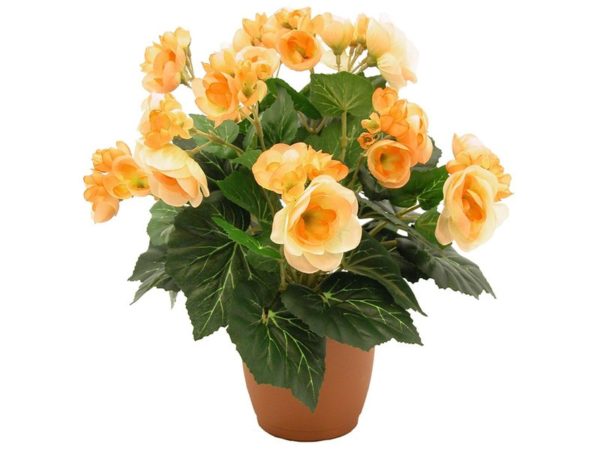
They are divided into groups:
- Decorative blooming.
- Decorative foliage.
Tuber begonia is considered the most popular, as it is unpretentious in care and boasts a rich palette of shades. The plant's favorite climate is subtropics and tropics. It prefers shady and humid places that are widespread in these latitudes. But there are species that grow well and spread on the steep coast of the sea, in the mountains and arid slopes.
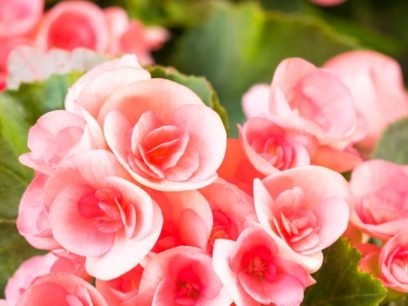
Begonia is varied not only in shape, but also in size and color. Some species are low grassy plants, others grow to the size of medium-sized shrubs. The leaves can have an incredible color, unusual in nature, covered with spots or bizarre patterns, which is considered quite normal for this plant.
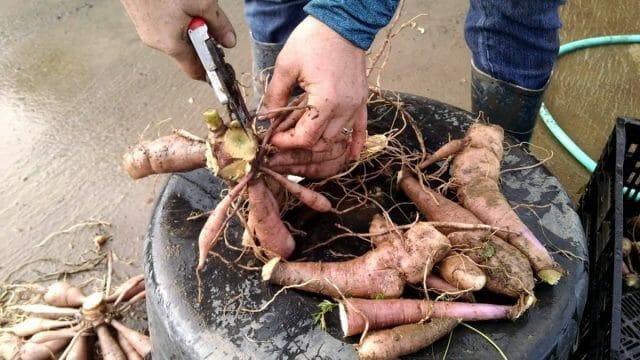 You may be interested in:
You may be interested in:Popular types of begonia:
- Decorative foliage. This flower has no stem - its leaves grow directly from the rhizome. Due to the various colors of the “crown”, this look fits perfectly into any interior. Popular representatives of this family are “Royal Begonia” and “Cleopatra Begonia”.
- Bush. The appearance of the stems of this plant is similar to bamboo. It grows up to 2 meters high and blooms year round. Often in homes you can find "Coral Begonia" and "Fuchsia Begonia".
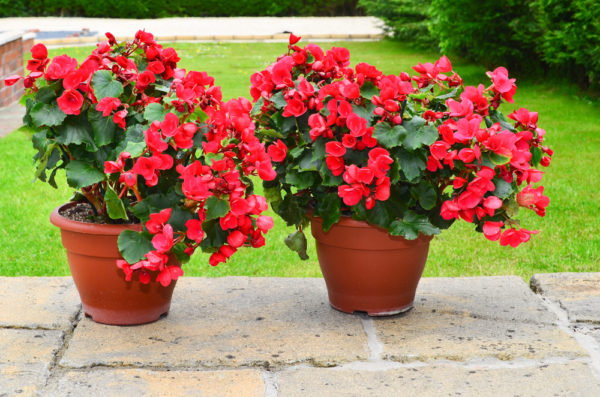
- Tuberous. Begonia got this name because of the tuberous root. The stems of the plant can reach up to 80 cm. The flowers are terry and simple, similar to roses or carnations, with a diameter of 3 to 20 cm. The leaves of the heart shape can be matte, glossy flat or corrugated. The color of the leaves of the plant is from light green to dark. Tuberous begonia blooms from May to October.
- Everlasting. This type of begonia can often be seen in urban flower beds. At home, evergreen begonias bloom all year round. Leaves are glossy, green or brown. The flowers are small, red, pink, white.
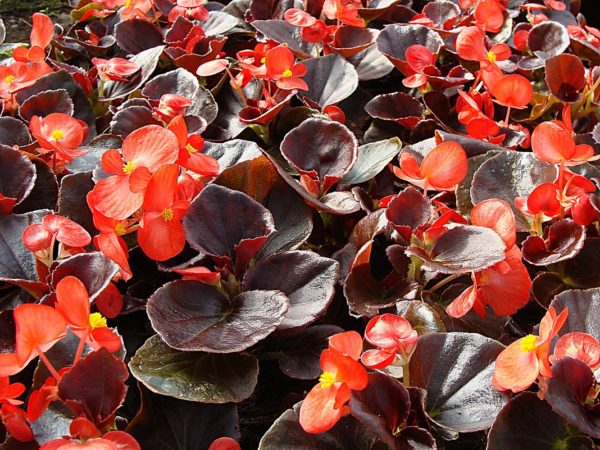
- Royal. Decorative leafy begonia. It differs in large up to 30 cm. Leaves painted in different shades of green, brown and red.The leaf plates may be in the shape of a heart or resemble a spiral.
- Ampelic. It is a subspecies of tuberous begonia. Planted for vertical gardening. The length of the shoots is from 25 to 50 cm. The plant is literally studded with flowers of raspberry, orange, yellow, white.
- Elator. The tuber begonia hybrid is intended for indoor cultivation. The shoots are thin, with a red tint, they need support. Flowers appear in autumn and winter. The foliage is glossy, rounded. Flowers with a diameter of 5 cm, painted white, yellow, red.
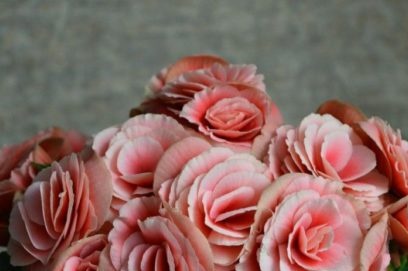
Many grow begonias at home, photos of which show the beauty of this plant. But still, some people often have the question of whether it is possible to keep it at home and how to properly care for the flower.
Begonia home care
Begonia can take away all year round, which is why caring for it at home after purchase should be special.
Lighting
It is very important that there is enough light in the room, since flowering plants are in dire need of it. However, it is better to protect it from direct sunlight in order to avoid burns on the foliage.
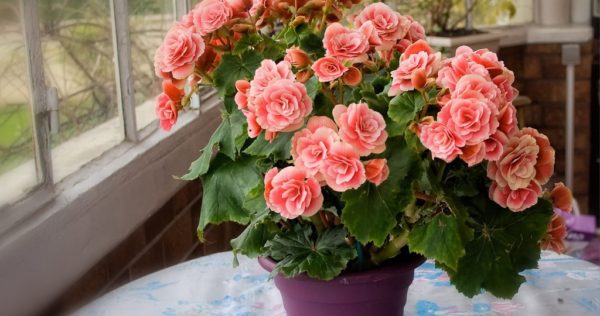
Temperature and humidity
The optimum temperature for this "domesticated" tropical plant is 21-23 ° C in the summer and 15-18 ° C in the winter. This flower loves moist air, but you should not spray it from the spray gun. This can cause brown spots on the foliage.
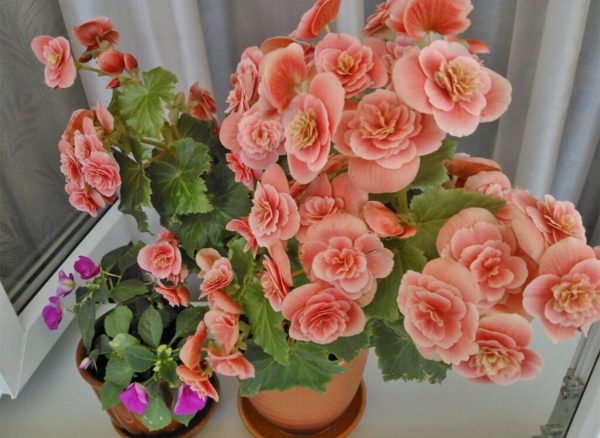
Watering and feeding
In the arid, summer period, begonia requires more frequent watering. But still water stagnation in the pan should not be allowed. It is best to use the settled liquid when 1 cm of soil in the pot has dried.
In winter, watering must be reduced. Particular attention should be paid to species that propagate by tubers. Since they “fall asleep” during the cold season, they must be placed in peat and moisture can be completely excluded.
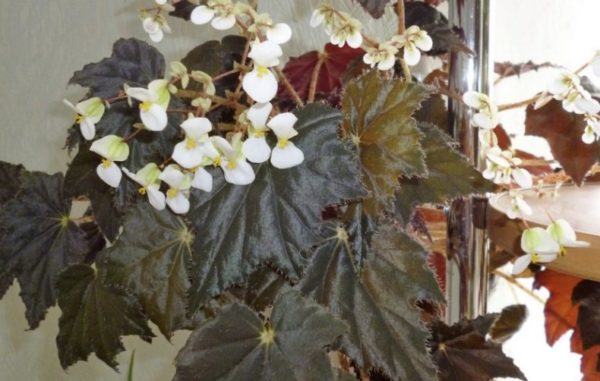
Feeding should start from the moment of flowering in order to support the plants and nourish it with the necessary trace elements. This should be done 1 time in 2 weeks. For deciduous varieties, nitrogen fertilizers are suitable, as they develop leaves and inhibit flowering.
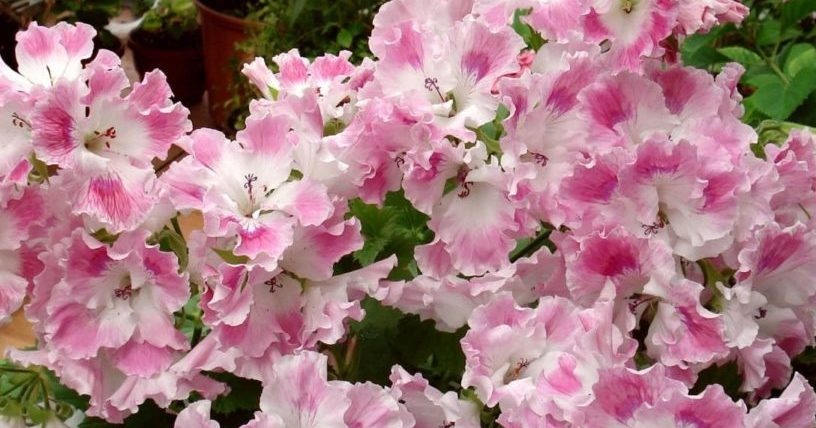 You may be interested in:
You may be interested in:Transplant Features
Begonia is undemanding to the soil. A suitable mixture can be purchased at a flower shop or made at home on their own. To do this, the pot should be half filled with sheet soil, and then add peat mixed in equal proportions with black soil. At the bottom of the tank, it is better to pour a little sand, which will retain precious moisture.
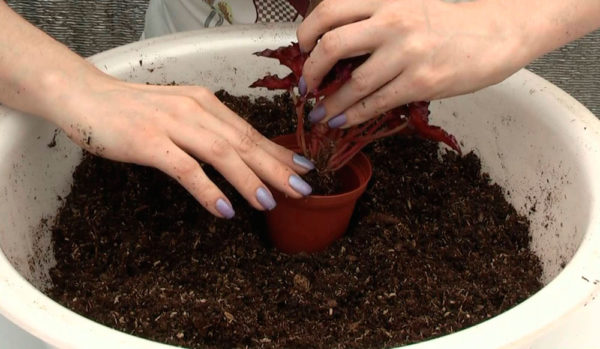
It is only necessary to transplant the plant if the roots no longer fit in the old pot. It is best to devote spring days to this cause. The plant must be carefully removed their containers, clean the roots of soil residues, dropping them into a weak solution of potassium permanganate, and cut off the decayed areas with scissors.
After that, the flower is ready to move to a new place. A recently transplanted plant needs abundant and frequent watering. In a month, begonia will finally get used to the new place.
What pot is needed for begonia
After buying begonias for proper care at home, you should choose a suitable pot for transplanting.To do this, you must adhere to several rules:
- To plant begonia cuttings, low pots with a diameter of 5-6 centimeters are suitable.
- About six months after planting, as the root system grows, the pot must be replaced with a larger one (8-10 cm).
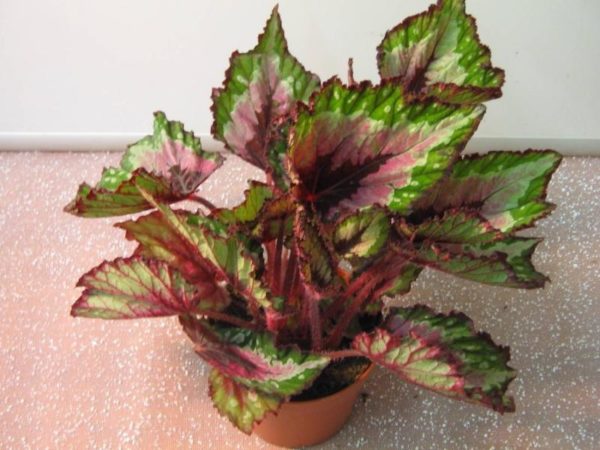
- After a year, already an adult begonia should be transplanted again into a container that will be one third more than the previous one. The pot should not be high.
- A prerequisite in each case is the presence of drainage holes.
- The material from which the pot is made does not really matter.
- Begonia should never be planted immediately in a large pot. The root system of a young plant may begin to rot.
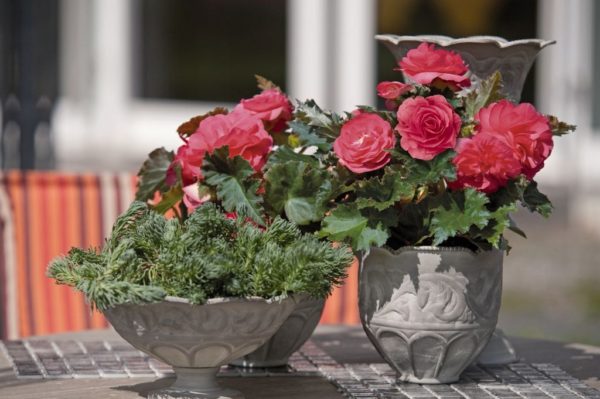
How to choose a begonia for planting in a pot
The popular type of begonia "Elator", the photo of which is decorated with many magazines devoted to interiors, requires careful care at home. But it is equally important to choose the right plant, so that in the future it does not bring a lot of anxiety.
First of all, in the store, when you buy a tuber, pay attention to how it looks. Its size should be at least 4 cm in diameter. Begonia tubers should have been dense, not over-dried, without damage and mold.
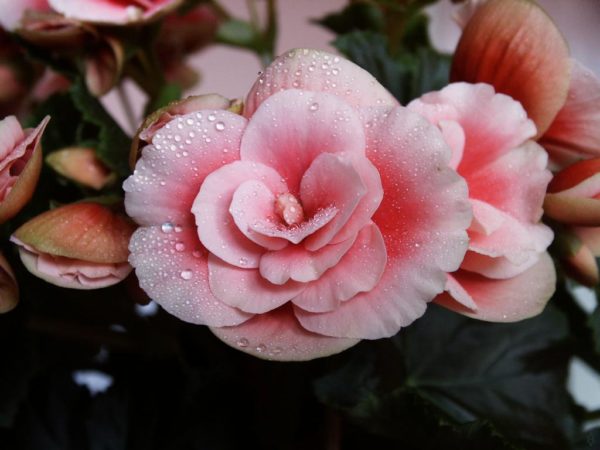
The bottom of the tuber should be convex, the top should be concave or flat. On the upper part you can find tubercles and irregularities - these are growth buds. Buying tubers in January or February is difficult to choose; they are still in hibernation. In late February or March, white or reddish buds are visible on healthy tubers.
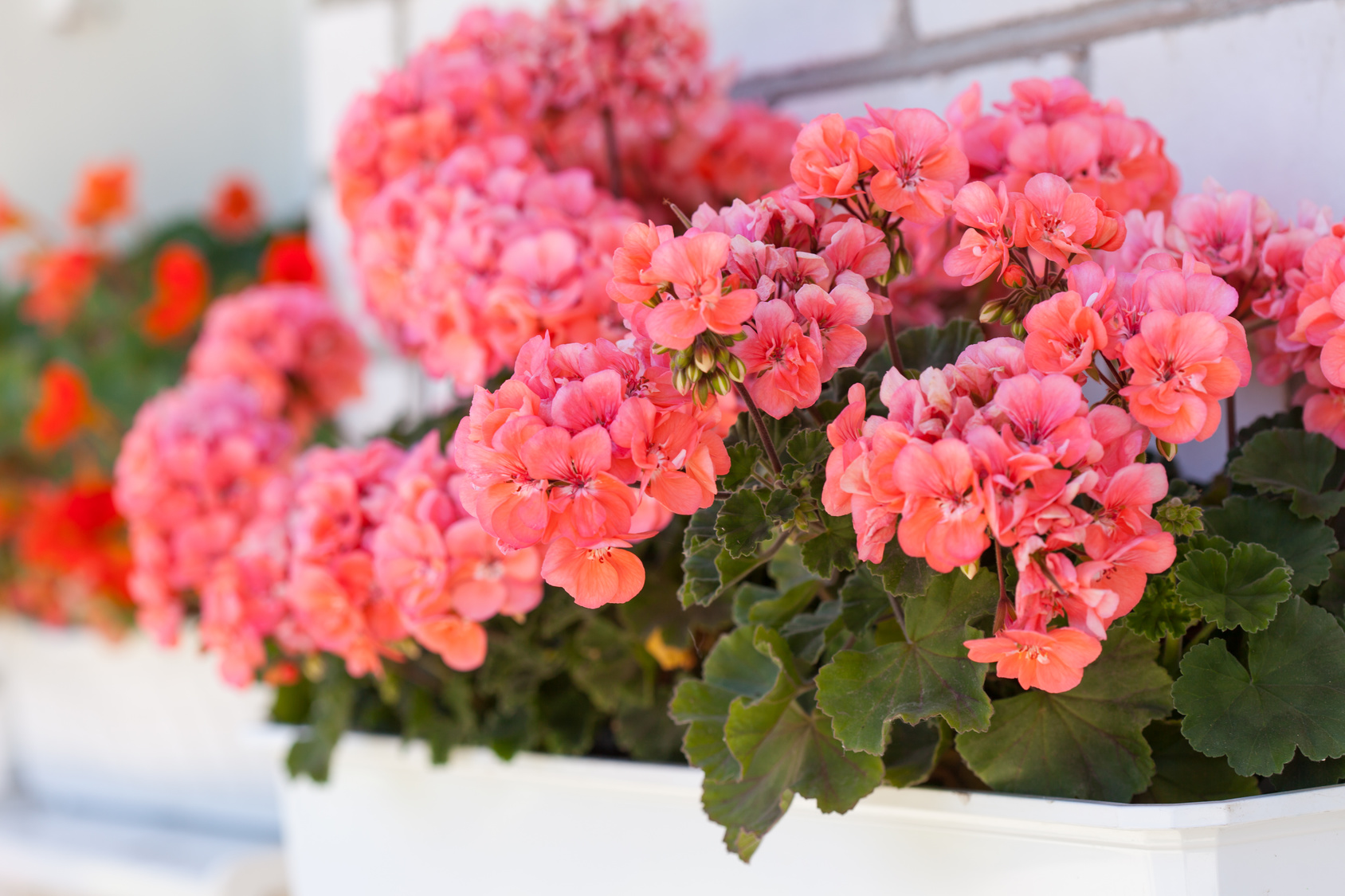 You may be interested in:
You may be interested in:How to plant begonia
Planting an evergreen begonia at home is a troublesome affair. But, despite this, loving owners do an excellent job of this task.
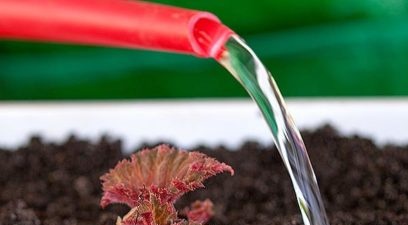
Even a novice will be able to transplant begonia if he takes into account the following recommendations:
- Begonia tuber is planted usually at the end of February or in March.
- Before planting, it is advisable to soak for a couple of hours in an epine or other growth stimulator. It can be treated with a fungicide or kept in a weak solution of potassium permanganate to protect against rot.
- A small depression is made in the soil, in which the tuber is placed with the growth points up.
- Do not sprinkle on top of the ground until the sprouts reach a size of 4-5cm. Thin delicate roots appear on the lower convex side of the tuber.
How to care for begonia in a pot at home after purchase
Elation begonia care at home should be carried out in accordance with all the recommendations below. This will ensure stable growth of the flower, which will delight its hosts with healthy foliage and beautiful inflorescences.
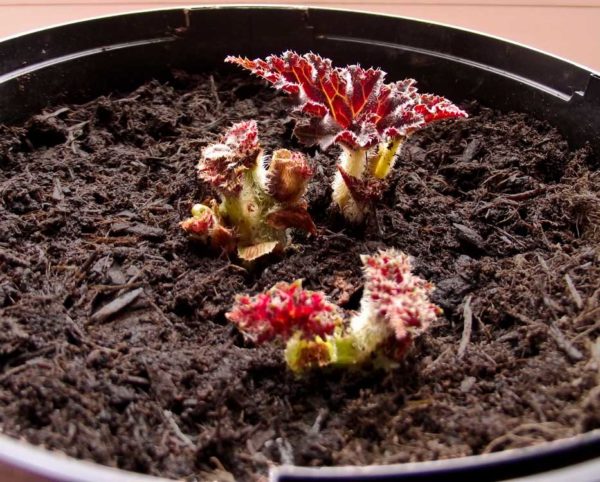
Further care
After planting, the substrate is carefully watered around the tuber, trying not to soak the tuber itself. If the soil sags much after watering, add a little more so that the tuber itself seems to be pressed into the substrate.
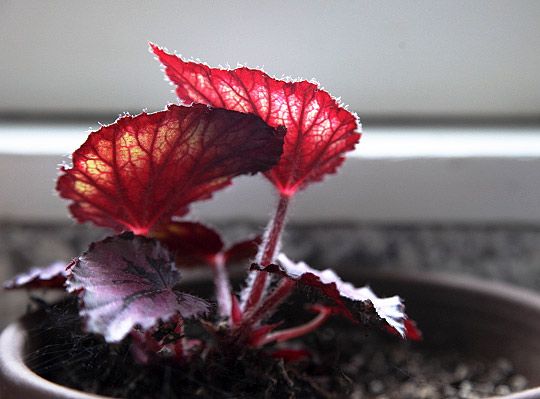
With regular watering and a temperature of + 22 ° C, tubers sprout quickly. When the shoots have grown to 4-5 cm, they pour the substrate in the pot so that the tuber completely disappears under it. After the leaves grow, watering is increased, but not excessively, and they are waiting for flowers.
Top dressing
For decorative-flowering begonias, top dressing is necessary during the beginning of budding and the entire flowering period. Fertilizers are applied no more than twice a month.
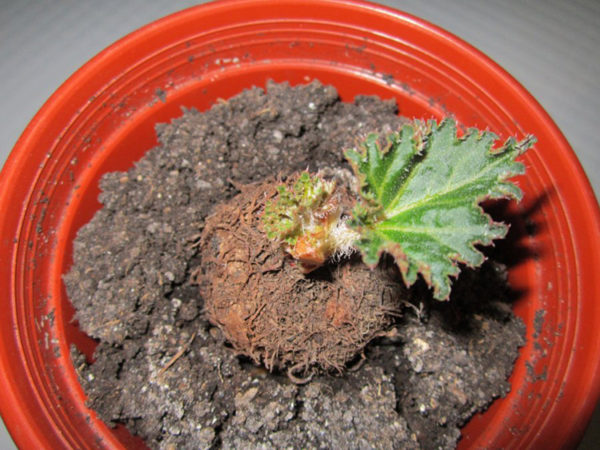
Top dressing should contain potassium and phosphorus, which blooming begonias need. For decorative leafy plants, nitrogen-containing fertilizers or complex compounds are used.
Pruning
Pruning begonias is a procedure without which it is impossible to grow a beautiful, healthy plant. Pruning is carried out not only to remove old, elongated leaves and stems, but also for the proper formation of a bush. But about all this in order.
- Left to its own devices, this plant loses its decorative effect: the stem stretches, the shoots become thinner, the leaves grow smaller, and flowering is minimal.
- Pruning is necessary to form a lush crown, improve flowering. In addition, the plant rejuvenates and takes on a well-groomed appearance.
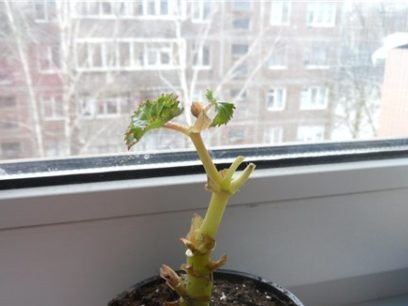
How to prune begonia:
- We need to think about the formation of the plant at the stage of a young flower. When a young begonia reaches a height of about 6-7 cm, the tip is cut off with a sharp knife. This is done to stimulate the development of side shoots.
- After this procedure, you should reduce the amount of watering before the start of intensive plant growth.
- As soon as the side shoots reach a length of 10 cm, their tops are trimmed.
- On this, the formation of a young bush ends. From time to time, you can shorten elongated stems or remove dried shoots to maintain the desired shape of the crown.
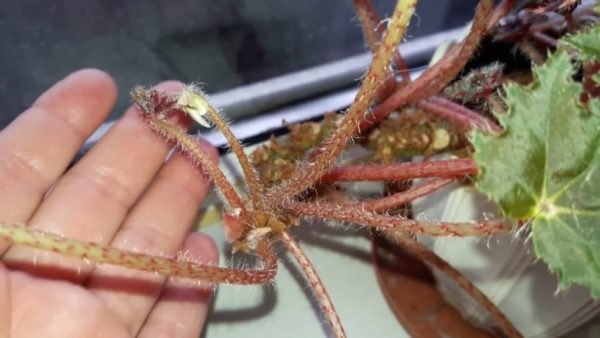
Cases when begonia should be trimmed:
- In decorative leaf begonias, pruning shoots should be cut.
- Dry, damaged leaves and shoots should be cut to avoid flower disease.
- A young plant is cut to give a decorative look.
- Tuberous begonias need pruning for the winter.
With the onset of autumn, room tuber begonia reduces the number of waterings. After the leaves have dried, the aerial part of the plant is cut, leaving 1-2 cm. After this, the flower pot should be put in place for wintering.
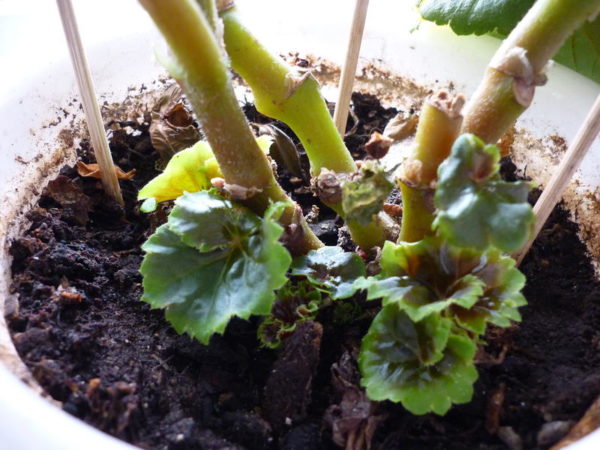
It should be a cool, dark place with a temperature not exceeding + 15 ° C. For this, a basement, a loggia is suitable, and in apartment conditions you can put it under the bath. From time to time it is necessary to irrigate to prevent the complete drying out of the earth.
The best time to cut is October. This period is considered optimal. Indeed, in February and March, the flower again "wakes up" after hibernation. And the six months that the plant will spend at rest is quite enough to relax, gain strength and in the summer to please with its unusually beautiful flowering.
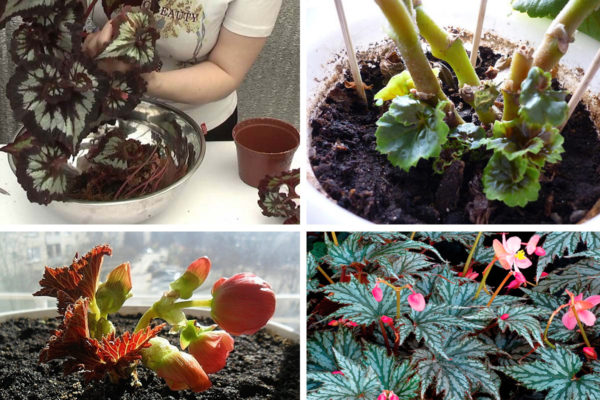
 You may be interested in:
You may be interested in:Transfer
Begonia tubers begin to be planted in March. The day before the transplant, the plant is watered, and a day later transplanted. The plant is removed from the pot with an earthen lump, then a small part of the root system is freed from the soil. Then the root part is placed in a weak solution of manganese. If there are damaged roots, then they are cut with a sharp, clean knife.
Cut points are treated with crushed activated carbon. The flower is placed in a new pot with a sufficient layer of expanded clay and drainage holes. After transplanting, the plants are watered. In this case, the upper part of the soil will settle, therefore, it is necessary to add the missing amount.
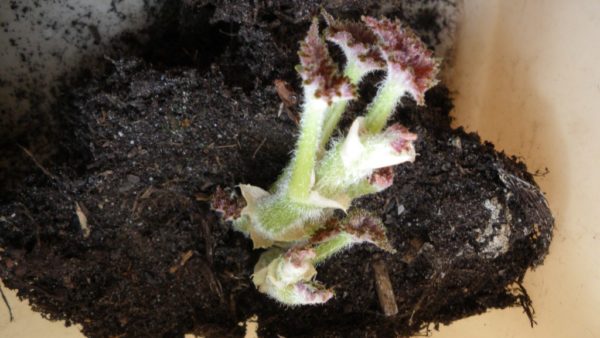
For several days, the begonia is not watered, the humidity is maintained by a bowl with moist expanded clay, on which a pot with a plant is installed. If necessary, then these days you can trim the plants. In the first seven days, begonias are kept in the shade, avoiding drafts.
How to care in winter
In winter at home, care for begonias should be special. This applies to plants that do not drop leaves.They should be kept at a temperature of 15 - 22 ° C and less often watered, but the humidity should still be maintained - cover the batteries with damp towels or put humidifiers (for a large collection of large items).
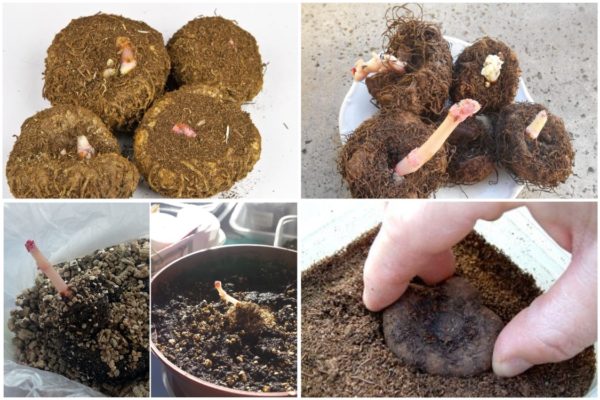
Tuberous begonias begin to prepare for dormancy in mid-autumn: their leaves gradually dry up and die off, so watering should be stopped and after dying off the ground part, transfer the pots to a dark cool place (10 - 15 ° C), where they will remain until the end of winter. If, until November, the tuberous begonias do not independently go to rest, they will greatly reduce watering and cut off the ground part after a while.
Diseases, pests
Quite often, begonia leaves and petioles undergo fungal diseases, most often - powdery mildew. For the most part, it is caused by an excess of moisture. Carefully monitor the condition of the core of the bush, as well as the lower leaves, in time to consider the problem.
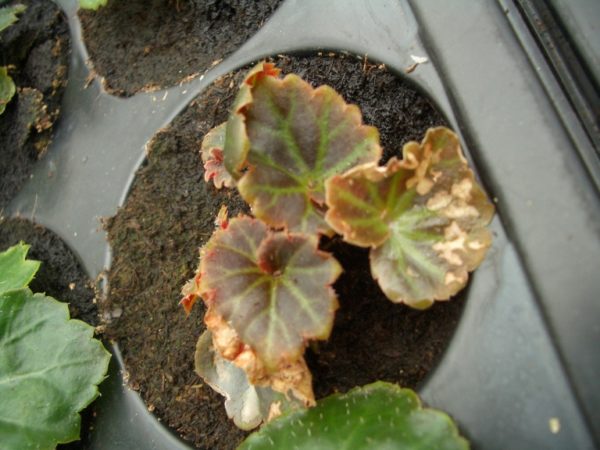
These places are the place of occurrence of rot and powdery mildew. If you still diagnosed this problem on your plant, you need to get rid of the damaged sheets, and then reduce the watering. Thus, you will be able to avoid the multiplication of the fungus throughout the plant.
The most common pests for begonias are red spider mites and aphids. To rid your plant of them, you need to generously spray the leaves with a solution of insecticides - Fitoverm, Intavir or Karbofos.
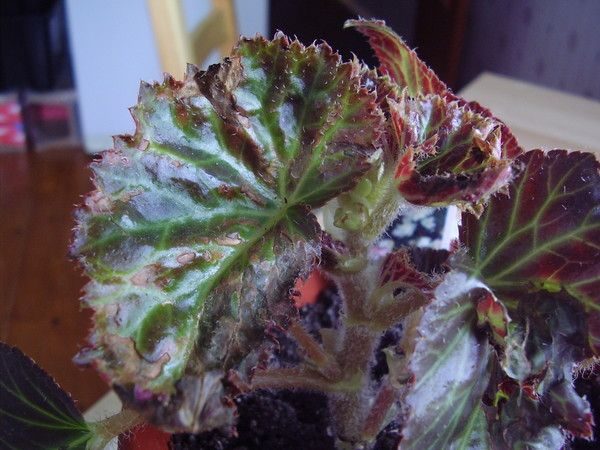
After this treatment, you need to place the plant in a moist cellophane bag so that the effect of the procedure is enhanced. However, if you carefully care for begonia, you don’t have to worry that such a problem will overtake you.
Possible problems and their solutions at home
No matter how well you take care of the plant at home, plant the tubers correctly, cut and water on time, sometimes begonia gets sick. Consider the main problem situations and how you can help the plant.
Begonia is a rather delicate flower, so it may happen that the plant will not bloom. This problem can be dealt with if you know the reason why the buds do not appear:
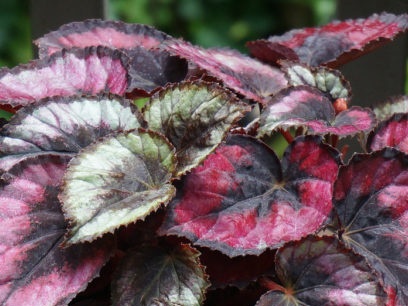
- Room temperature is too low.
- Draft.
- Very hot in the room.
- The air is too dry.
- Excess fertilizer.
- The pot is too big.
- The flower has recently been transplanted.
It also happens that the buds begin to fall from begonias immediately after emergence. This phenomenon also has a number of reasons:
- Little sun.
- Watering is carried out incorrectly.
- There are insufficient nutrients in the soil.
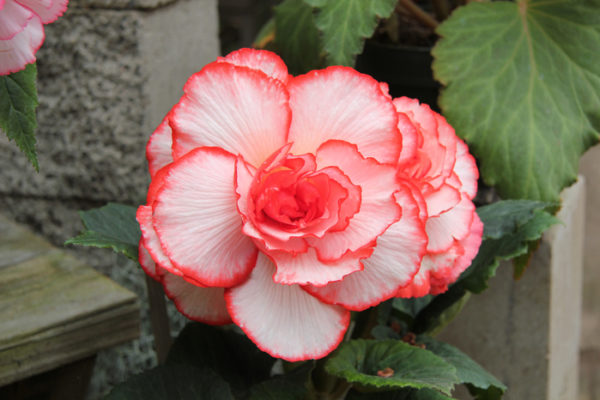
Yellowing and drying of the leaves of the plant most likely indicates that the flower does not have enough moisture. Yellowness can also be caused by pests that attack the roots of the plant.
The reasons why plant leaves can curl:
- The temperature in the room is too low or too high.
- Excess moisture.
- Lack of top dressing.
- Leaf redness
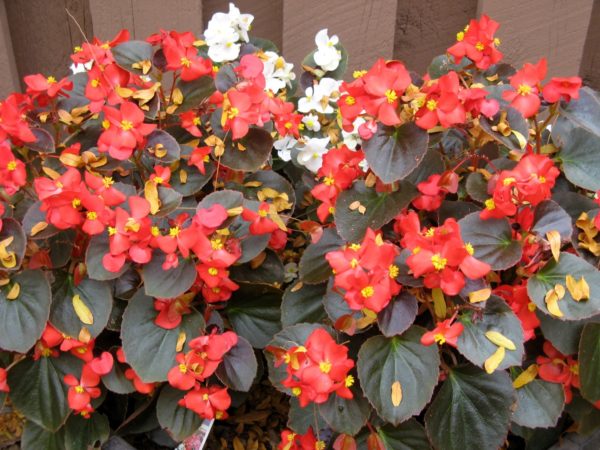
The cause of redness of begonia leaves is an overabundance of light. Chlorophyll begins to disappear gradually, due to this the color of the sheet changes. One of these actions will help to solve the problem:
- Move the pot with the plant in a less lit place.
- Shorten the time when the flower is in the sun, for example with a curtain.
Home care for begonias seems difficult only at first glance. In fact, there are only four main points, correctly performed which, you can enjoy this flower for many years.




 Sow in the ground, without seedlings: 10 beautiful and unpretentious flowers
Sow in the ground, without seedlings: 10 beautiful and unpretentious flowers Platicodon planting and outdoor care
Platicodon planting and outdoor care Hosta - planting and care in the open ground in the Urals
Hosta - planting and care in the open ground in the Urals Oleander - care and growing at home
Oleander - care and growing at home